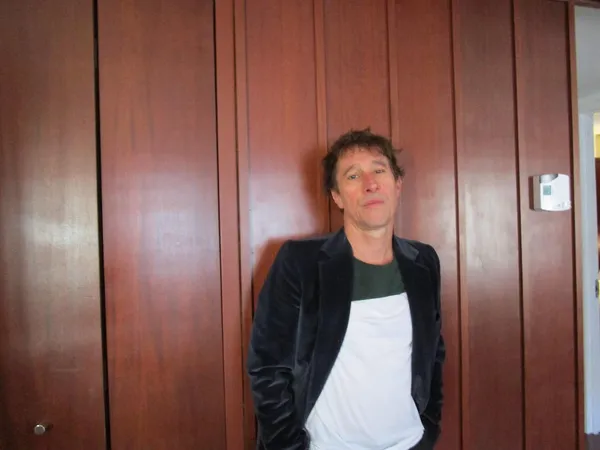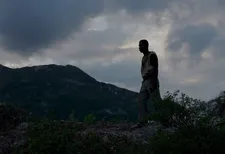In the second half of my conversation with Bertrand Bonello on Zombi Child, shot by Yves Cape (Leos Carax’s Holy Motors) featuring Mackenson Bijou, Louise Labèque, Wislanda Louimat, Katiana Wilfort, Adelé David, Ninon François, Mathilde Riu, and Patrick Boucheron, the director notes the change in the genre from Victor Halperin’s White Zombie to George A Romero’s trilogy (Night Of The Living Dead, Dawn Of The Dead, Day Of The Dead) in response to my comment about Jacques Tourneur's I Walked With A Zombie.
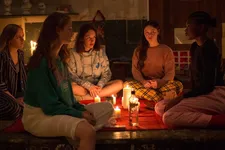 |
| Bertrand Bonello on Zombi Child: “The construction is very precise.” |
The director/screenwriter of Nocturama; Saint Laurent (co-written with Thomas Bidegain, starring Gaspard Ulliel as the iconic designer Yves Saint Laurent and Jérémie Renier as his partner Pierre Bergé); House Of Tolerance (with Adèle Haenel and Jasmine Trinca); Ingrid Caven: Music And Voice; and Tiresia has included Brian De Palma’s Carrie; Richard Donner’s The Goonies; Wes Craven’s The Serpent And The Rainbow; Maya Deren’s Divine Horsemen: The Living Gods Of Haiti; William Friedkin’s The Exorcist: Extended Director's Cut, and the classic, I Walked With A Zombie, to screen in the program Origin Stories: Bertrand Bonello’s Footnotes to Zombi Child at the Quad Cinema in New York.
Bertrand told me that he did a lot of research for Zombi Child through ethnological books.
Anne-Katrin Titze: It is clear that when you speak of the Zombies, the idea of slavery is not very far. You also explore traditions that many people in the audience may never have heard of. What is the thing with the meat? Once the Zombies eat meat they regain their memory?
Bertrand Bonello: It's a lot of research I did.
AKT: You didn't make anything up?
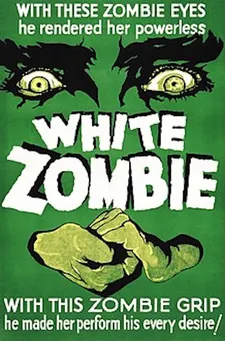 |
| White Zombie poster |
BB: It's from ethnological books. It's true that if a Zombi eats meat or salt, he gets out of that weird state. I don't know why, but it's what happens. I have no imagination.
AKT: You have no imagination? That's good to know. These ethnological details make the story come to life. I am really no expert on Zombies. I think Jacques Tourneur's I Walked With A Zombie is the only film of that genre I have ever seen.
BB: It's not the worst!
AKT: And now yours.
BB: There are not very many films about these kind of Zombies. You have [Victor Halperin’s] White Zombie, from 1932, I guess. Then Jacques Tourneur's film. And then the Zombi becomes something very different. Like in the trilogy by George Romero, it's like people are really dead that don't find any place in hell. They come back on earth. But the Haitian Zombi, to be brief, there are not many movies.
AKT: And that other Zombie-genre didn't interest you very much?
BB: No, it's different. It's just something else.
AKT: Many of the images are day for night.
BB: Yes.
AKT: I noticed that you have two shots very often of the moon. Two that are very different in colour. One right after the other. Both are extremely fascinating.
BB: It's editing, you know. I edit like if you were doing some music. It's like playing twice the same note. But the second time it's not the same as the first time because you had the first time.
AKT: So it's in miniature what you're doing with the entire film?The figure of the Baron who is conjured up, I suppose he is also a figure you discovered in your research?
BB: Yeah. It's probably the most famous spirit of the Haitian history. I decided to give him flesh and blood for a few images. That was a tough decision. It's not supposed to. At the same time there are ….
AKT: There are consequences to doing that?
BB: No, there are so many drawings of him, paintings of him. So we know how to represent him. Even the voice, his kind of way of talking with a nasal voice. Yeah, I gave him flesh and blood for a few scenes.
AKT: He seems as conjured up as the boyfriend does, who appears in the fantasies of Fanny. There seems to be a link between them on that level also, not just in the ritual. The question of how do you fantasise? How do you conjure?
BB: Yeah, yeah, yeah. I think the film had for the ending to push a level in the fantastic, I would say.
AKT: Of all choices, you have the girls sing Silent Night in English?
BB: I liked the contrast of this very sweet song and the sorrow of the girl. She is crying and crying and then she has her music lesson and they are playing this Christmas song, which is at the same time sweet and sad. And I liked the contrast of the two.
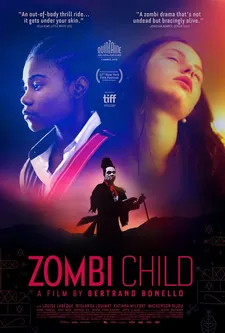 |
| Zombi Child poster - opens on January 24 in the US |
AKT: It adds another dimension too. It's not just France and Haiti - it's a German, Teutonic song, sung in English. It's widening the horizon. There is a mention of "the spirit of the grass snake". What is that all about?
BB: Grass snake? I don't remember.
AKT: The aunt is mentioning it several times.
BB: Oh, yeah, this is something that came from her.
AKT: She has the ruins as her wallpaper. You mention the big earthquake that killed the family.
BB: In fact, it's the castle of Le Roi [Henri] Christophe. Who was someone very important in the independence of Haiti. He had this huge castle built in 1810, I think, and there was an earthquake in 1840.
So when she comes to France, she wants to bring some things from her country. This is like an image of the kingdom of Le Roi Christophe. I know it's not very clear in the film but for me it's okay. It's just her and this image.
AKT: At the end it shows how the two worlds are interconnected. At first we think this is in two parts and these two worlds have little in common.
BB: Yes. the construction is very precise. You have the two parallel in editing, and you're asking yourself what's going to happen. And after an hour you have another character come in, which is the aunt. And she makes the bridges between Haiti and France through something that reaches up in a way.
AKT: Which you didn't do in Nocturama.
BB: No, Nocturama, it's two parts, like really clear. One hour, one hour.
 |
| Jacques Tourneur's I Walked With A Zombie to screen in Origin Stories: Bertrand Bonello’s Footnotes to Zombi Child at the Quad Cinema |
AKT: I was thinking if you did anything like that in your past films - the split? In Saint Laurent?
BB: Yeah, Saint Laurent, even House of Pleasure or Tiresia X. I think I really like putting stuff together that has nothing to do with each other. And when you put them together something appears.
AKT: It's like cooking.
BB: Yes, but for example if you think about Zombi Child, it's two very simple stories. A Zombi, you know.
AKT: Very simple.
BB: No, but simple to understand. Someone you pretend that he is dead and you pull him out of the grave and make a slave of him. It's quite simple. And on the other side you have the sorrow of a young girl. And when you put the stories together, a lot of things appear. It becomes more complex. How to make something complex with two simple things.
Read what Bertrand Bonello had to say on Olivier Meyrou's Yves Saint Laurent documentary, the song Papa Legba, the natural sound and history of the boarding school in Zombi Child.
Origin Stories: Bertrand Bonello’s Footnotes to Zombi Child at the Quad Cinema starts on January 17
Zombi Child opens in the US at the Quad Cinema and Film at Lincoln Center on January 24








